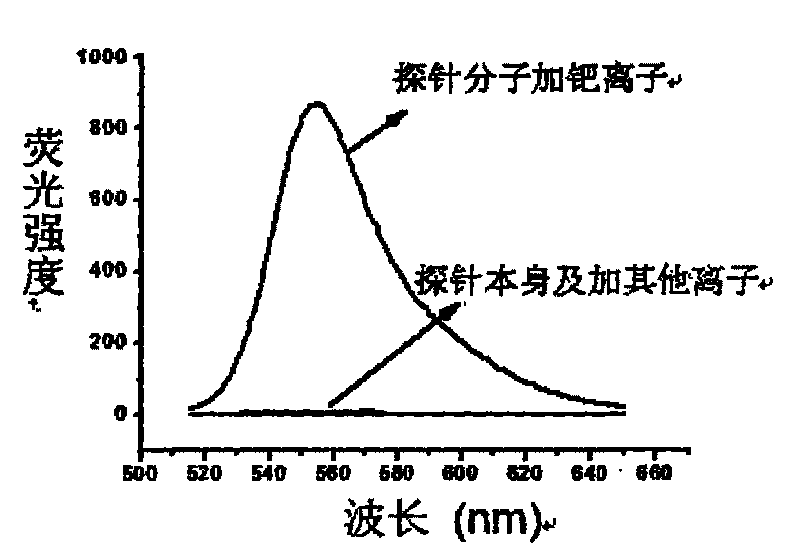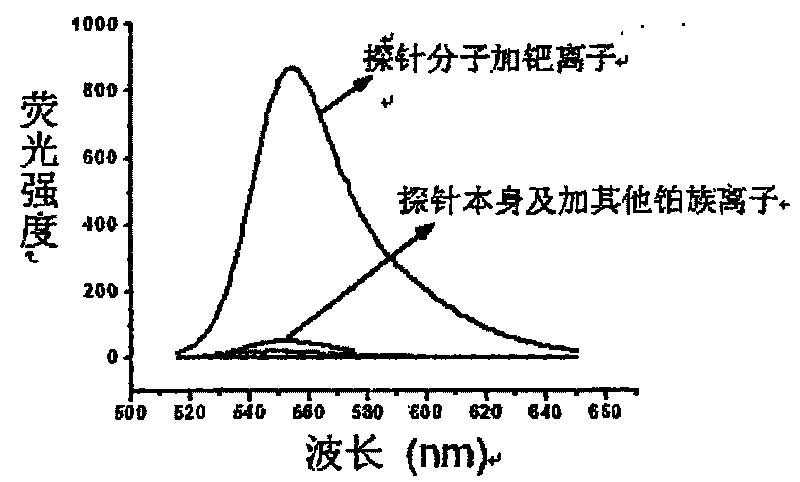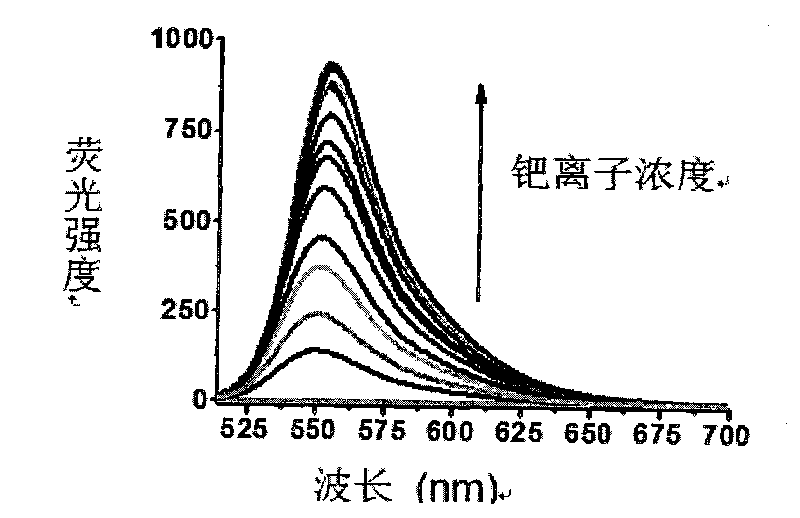Fluorescent probe compounds, preparation method and use thereof
一种荧光探针、化合物的技术,应用在荧光探针化合物及其制备领域,能够解决平衡时间长、不能用于检测零价钯等问题,达到荧光强度增强、反应条件温和、紫外吸收增强的效果
- Summary
- Abstract
- Description
- Claims
- Application Information
AI Technical Summary
Problems solved by technology
Method used
Image
Examples
Embodiment 1
[0075] Example 1 Synthesis of fluorescent probe compound RPd1:
[0076]
[0077] (1) Synthesis of intermediate 1
[0078] Rhodamine 6G (1.2 g, 2.5 mmol) was added into a 100 ml single-necked flask filled with 30 ml of ethanol. Stir vigorously at room temperature, and then measure 3 ml of 85% hydrazine hydrate (excess). After the dropwise addition was completed, the mixture was refluxed in air for 2 hours. The solution color first changed from dark purple to light brown and finally almost clear. After cooling to room temperature, the ethanol was distilled off under reduced pressure. Then 50ml of hydrochloric acid (1M) was added to obtain a red solution; while stirring, 70ml of sodium hydroxide (1M) was added until the pH reached between 9-10, and a large amount of precipitation appeared. Filter and wash the filter cake 3 times with 15 ml of water. After vacuum drying, 0.64 g of the target product was obtained by column separation, with a yield of 60.0%. 1 H NMR (400MHz...
Embodiment 2
[0081] Example 2 Fluorescent probe compound RPd1 selectivity to palladium ion:
[0082] The selectivity to palladium ion was evaluated using the compound RPd1 synthesized above. Add 10 μM compound RPd1 to the ethanol solution of the same amount of various metal ions, the excitation wavelength of the probe is 505nm, and the emission wavelength of the probe is 552nm. The test results are shown in figure 1 middle. It can be seen from the figure that the fluorescent probe compound RPd1 has a high selectivity to palladium ions, and the addition of palladium ions produces a large fluorescence and ultraviolet enhancement. In addition, metal ions such as sodium, potassium, calcium, magnesium, and copper are highly selective Detection without interference. The abscissa is the wavelength (nm), and the ordinate is the fluorescence intensity. The instrument used is a fluorescence spectrophotometer, model: LS 55.
Embodiment 3
[0083] Example 3 The selectivity of fluorescent probe compound RPd1 to common platinum group metal ions:
[0084] The selectivity to palladium ion was evaluated using the compound RPd1 synthesized above. Add 10 μM compound RPd1 to the ethanol solution of the same amount of various common platinum group metal ions. The excitation wavelength of the probe is 505nm, and the emission wavelength of the probe is 552nm. The test results are shown in figure 2 middle. It can be seen from the figure that the fluorescent probe compound RPd1 has a high selectivity for palladium ions, and the addition of palladium ions produces a large fluorescence and ultraviolet enhancement. In addition, metal ions such as platinum, rhodium, and ruthenium do not interfere with the detection. The abscissa is the wavelength (nm), and the ordinate is the fluorescence intensity. The instrument used is a fluorescence spectrophotometer, model: LS 55.
PUM
 Login to View More
Login to View More Abstract
Description
Claims
Application Information
 Login to View More
Login to View More - R&D
- Intellectual Property
- Life Sciences
- Materials
- Tech Scout
- Unparalleled Data Quality
- Higher Quality Content
- 60% Fewer Hallucinations
Browse by: Latest US Patents, China's latest patents, Technical Efficacy Thesaurus, Application Domain, Technology Topic, Popular Technical Reports.
© 2025 PatSnap. All rights reserved.Legal|Privacy policy|Modern Slavery Act Transparency Statement|Sitemap|About US| Contact US: help@patsnap.com



